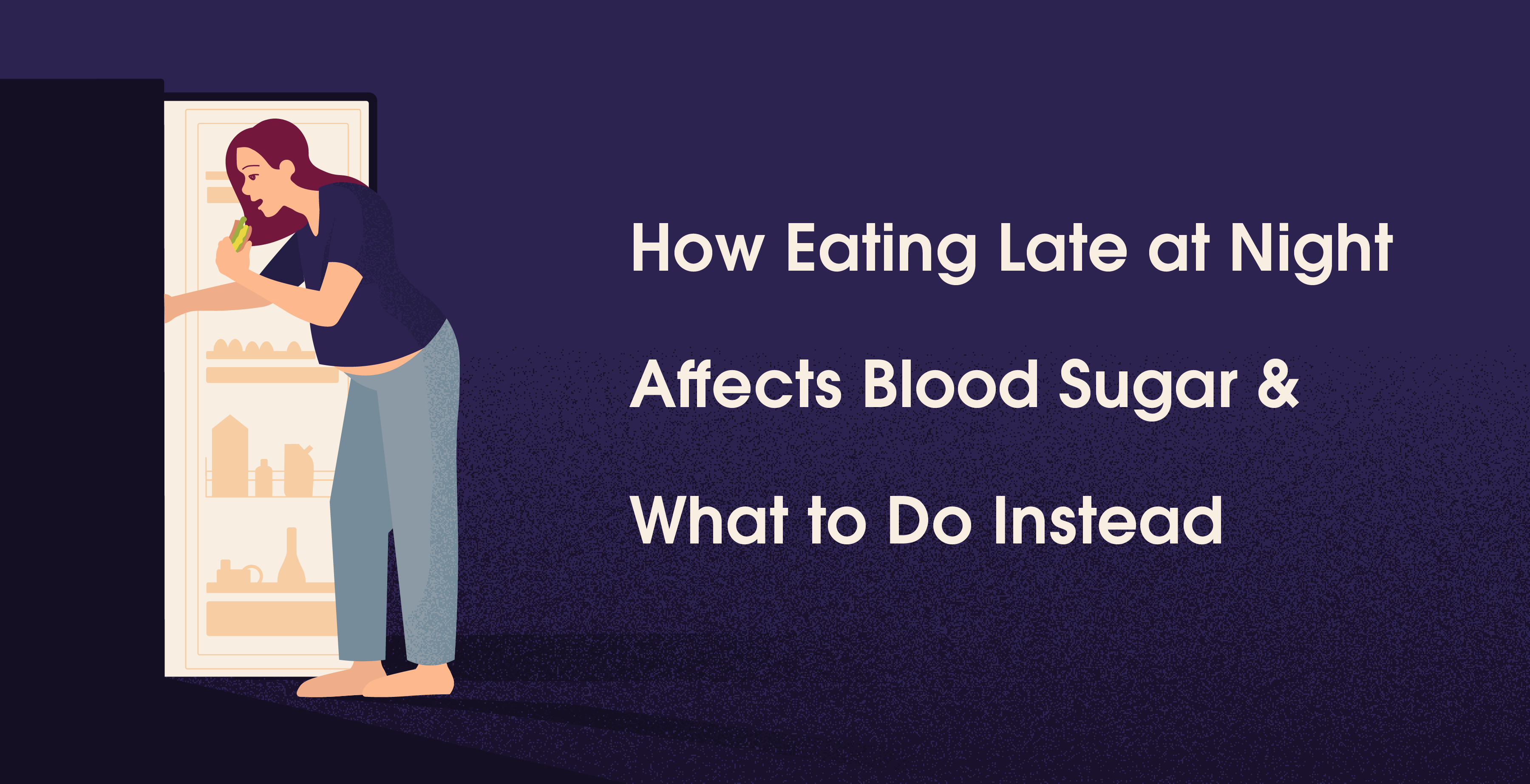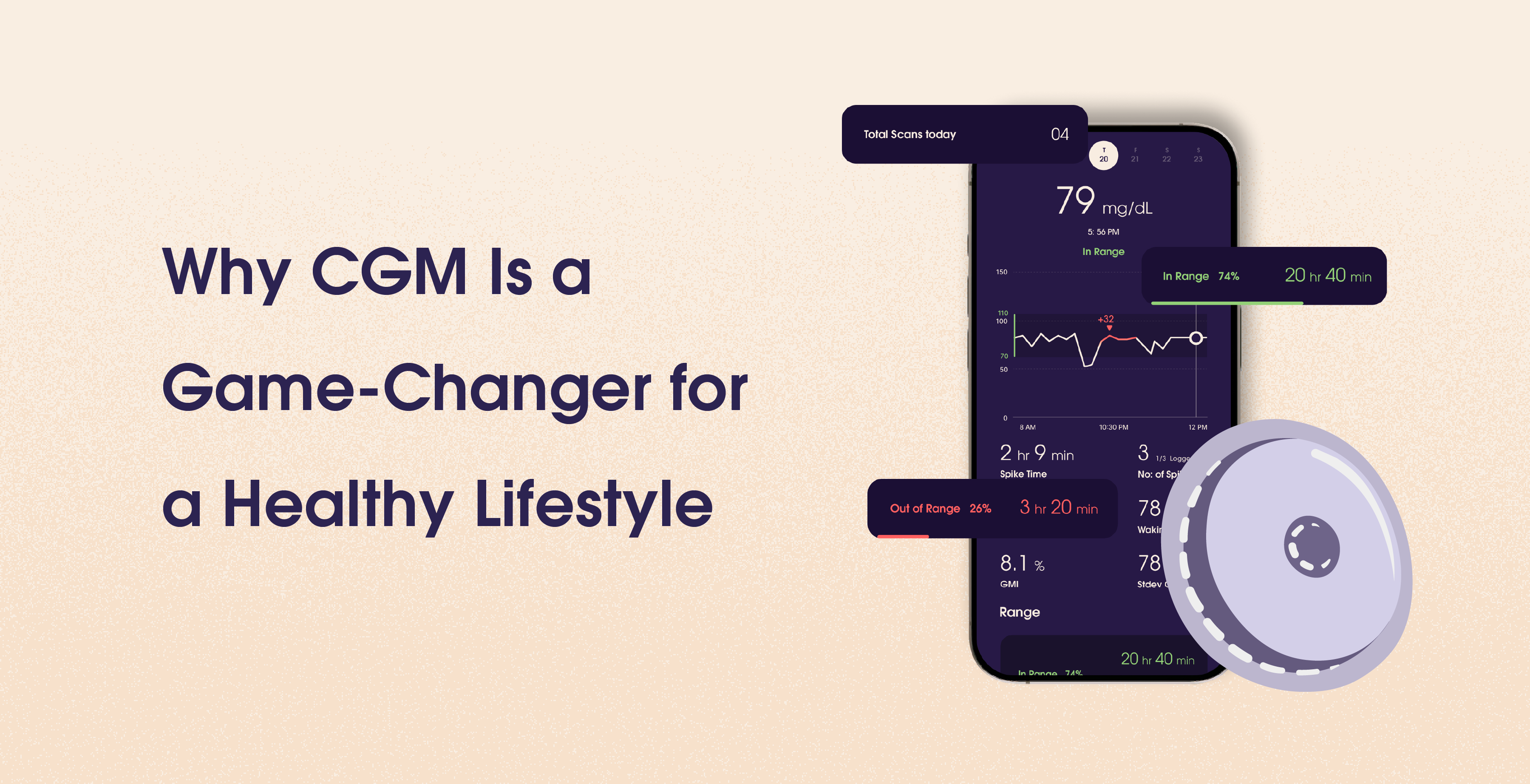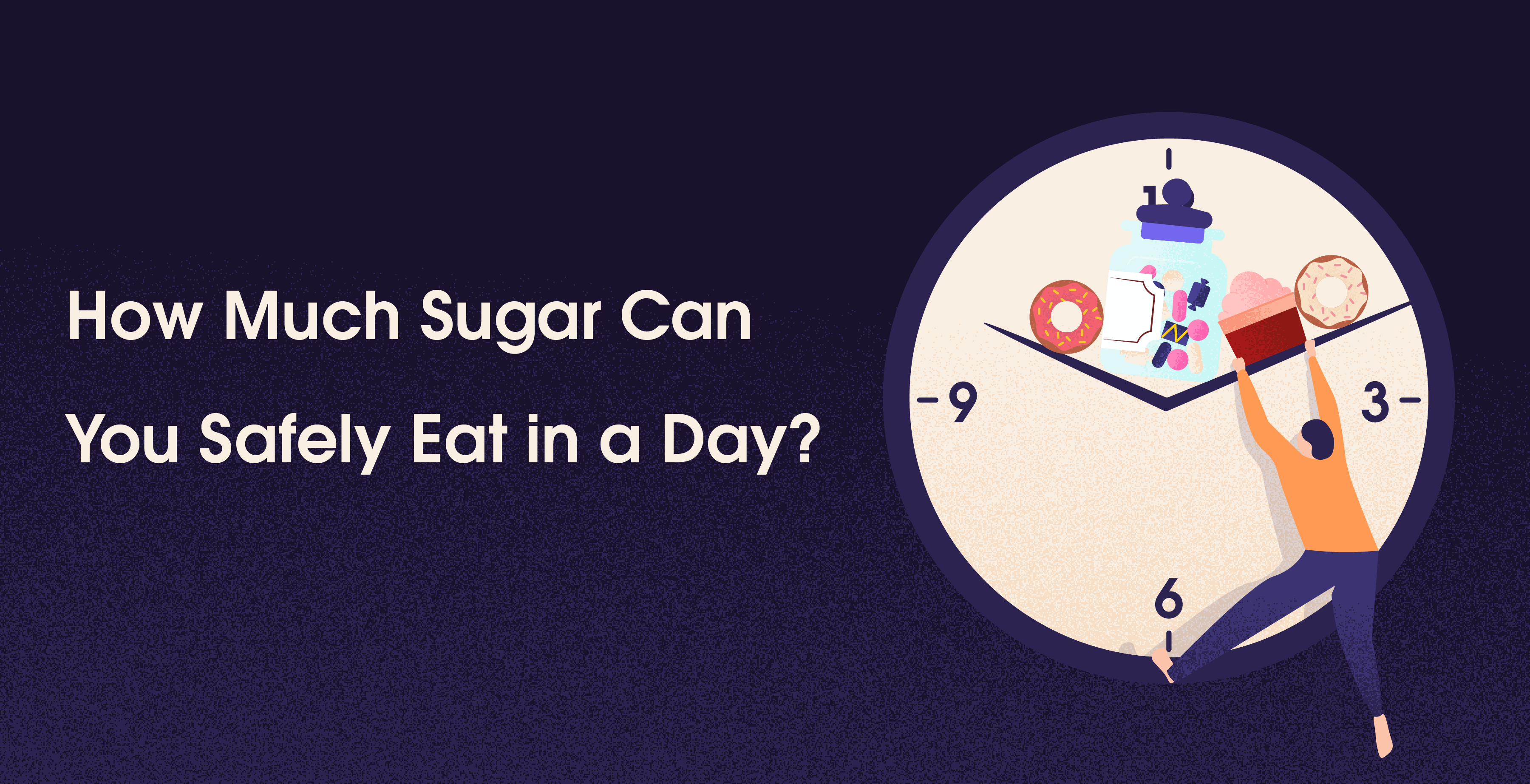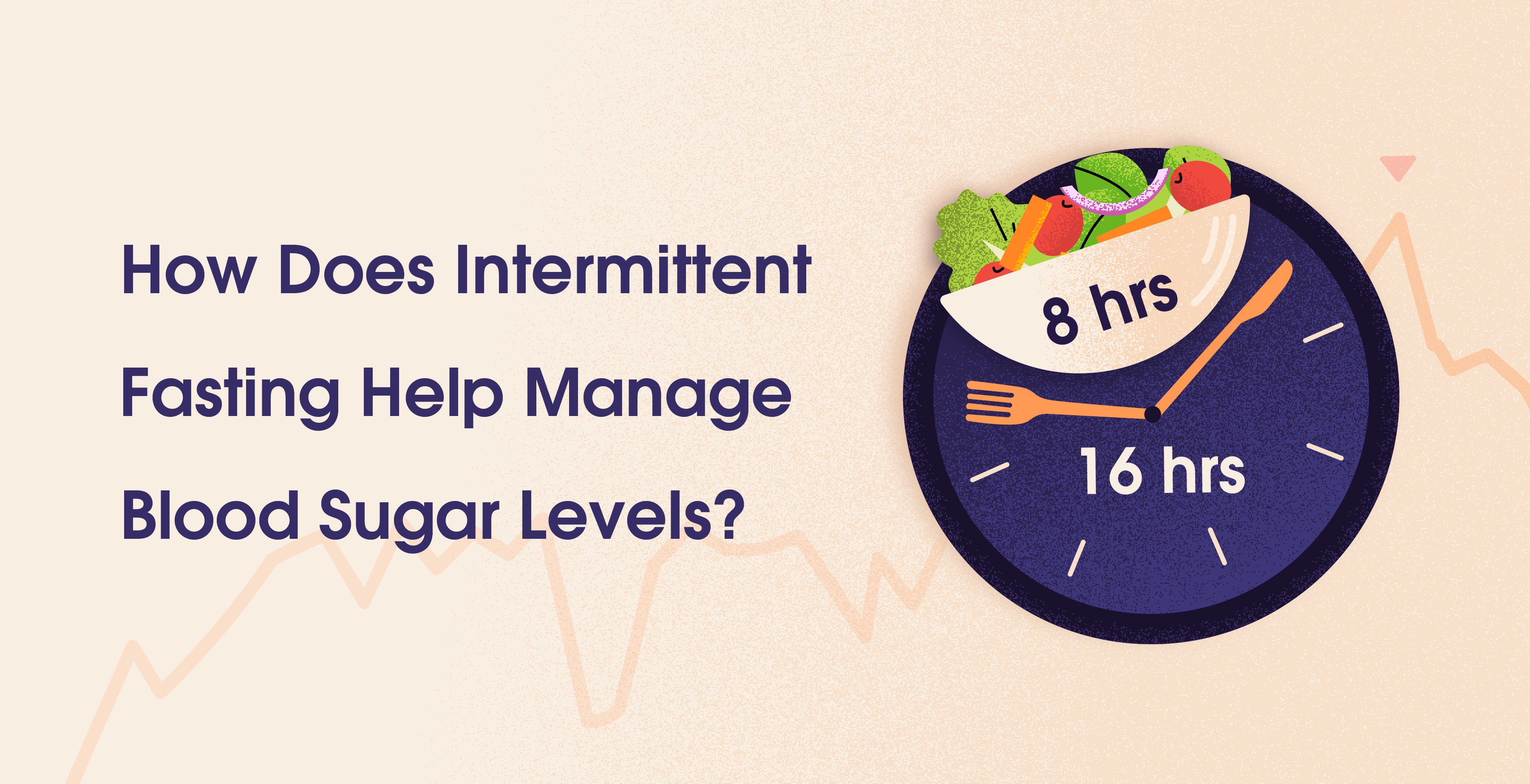A Guide To Prediabetes Symptoms & Risks
Jan 13, 2024
Ashima Raizada



Table Of Contents
Imagine going about your day when you start noticing some changes in your body. You're dealing with more acne than usual, feeling a bit foggy in the brain, and seeing hyperpigmentation on your skin. Meanwhile, that stubborn belly fat just won't go away, no matter how hard you hit the gym.
Or perhaps you're experiencing an always growling stomach, unquenchable thirst, constant fatigue, and tingling sensations in your fingers and toes. Your doctor recommends a blood sugar test to rule out prediabetes, but you might chalk it up to getting older and daily stress.
Fast forward to a routine check-up, and boom, there it is - prediabetes in the results. But you didn't experience any prediabetes symptoms? Unless you missed them. Your doctor now advises you to be vigilant and make some changes to avoid full-blown diabetes, but you might shrug it off casually. Well, we are here to tell you, don't shrug it off. It needs attention. Let us check out how prediabetes symptoms affect you and how you can take charge of your blood sugar levels in this article.
Highlights
Prediabetes is when your blood sugar levels are elevated but not enough to classify it as diabetes.
Insulin resistance is directly responsible for prediabetes which often comes without symptoms.
Prediabetes can sometimes whisper warnings including unquenchable thirst, constant fatigue, blurry vision, frequent urination, and darkened skin patches.
Certain factors put people at a higher risk of prediabetes, such as being over 45, having a family history of type 2 diabetes, carrying extra weight, or coming from specific ethnic backgrounds.
Lifestyle changes such as regular exercises, eating right and stress management can help improve prediabetes and its symptoms
What Prediabetes Is And Why Bother About It?
Let's break down the basics of prediabetes. Prediabetes is when your blood sugar levels are elevated but not enough to classify it as diabetes. According to the CDC (Centers for Disease Control and Prevention), a fasting blood sugar level of 99 mg/dL or lower is good, 100 to 125 mg/dL is a warning sign (that's prediabetes), and 126 mg/dL or higher means you're in the diabetes club
So prediabetes is like a subtle warning from your body, a hint that something might be up with your health. If you ignore it, there's a good chance that 37% of you could end up with actual type 2 diabetes within a few years. It also brings a bunch of health problems like heart disease, kidney issues, nerve troubles, vision problems, and more. Managing diabetes is an expensive and complex endeavor that demands constant attention.
But the good news is, research shows that with some lifestyle changes, you can cut that risk to 20% or less. If you're prediabetic, lifestyle changes can help resolve it much before you even reach diabetes. Now let's understand the science behind prediabetes to really help you tackle it.
Understanding the Role of Insulin in Prediabetes
Increased blood sugar is directly responsible for prediabetes. But why do we suddenly have increased blood sugar levels when our body has been fine all along? Well, that's where insulin resistance steps in.
When we eat, carbohydrates are broken down into glucose to keep our body energized. This happens with the help of a hormone called insulin, which allows your cells to absorb glucose. However, when there is too much glucose, the cells of your muscles, fat and liver stop responding to insulin, leaving too much glucose in your bloodstream. This is what we call insulin resistance. Insulin resistance is thought to precede the development of T2D by 10 to 15 years.
Now, this is where things can go wrong for you. High blood sugar levels can bring on intense prediabetes symptoms that affect your physical and mental health. And sometimes, prediabetes can come without any symptoms at all. Confusing right? We thought so too. But here's the thing - if you don't take action, it could lead to type 2 diabetes which is much more difficult to manage and causes other serious illnesses.
A little extra for our science nerds: Take a look at this video by Mayo Clinic to understand how insulin works and how insulin resistance affects our system.
Let's explore prediabetes symptoms, effects on blood sugar, and prevention of diabetes onset.
Prediabetes Symptoms - Clear Signs You Shouldn't Ignore
Prediabetes often strikes silently, but your body might whisper warnings. Let's uncover these subtle signs of prediabetes, decoding the body's quiet alerts that something's amiss.
Unquenchable Thirst
This isn't your ordinary post-workout thirst. It's an all-day, never-ending kind of thirst since your body is trying to get rid of the excess blood sugar faster than you can sip water.
Constant Fatigue
Ever feel like you're running on empty, even after a good night's sleep? With high blood sugar present and your body is unable to use it the right way, your body's energy is sapped.
Blurry Vision
Not the usual “I need glasses” blur. High glucose levels cause your body's fluids to shift, leading to a condition called diabetes-related retinopathy. (1)
Frequent Urination
The body tries to get rid of excess sugar through urine, making your trips to the bathroom more frequent. This happens especially at night when the body is in its detoxification phase.
Slow Wound Healing
High blood sugar stiffens blood vessels and slows down immune cells, making it hard for your body's natural repair tools to reach and heal wounds efficiently.
Unexplained Weight Changes
When your body doesn't handle blood sugar like it should, it causes changes in your weight. You might lose weight because your body's working overtime to get rid of the blood sugar, or you might gain weight due to eating more from mixed-up hunger signals.
Tingling or Numbness
Elevated blood sugar levels can damage nerve fibers, a condition called neuropathy. This can cause numbness or tingling in the hands and feet.
Darkened Skin Patches
Insulin resistance can cause skin cells to multiply unusually fast, leading to a condition called Acanthosis Nigricans. It leads to darker and thicker patches of skin in some areas such as the neck, armpits and groin. (2)
Remember, these symptoms can be sneaky and vary from person to person. But if you notice a combination of them, don't wait! Early recognition and intervention are what can help you stay ahead of the diabetes curve. (3)
What Fuels Prediabetes
While the exact causes of prediabetes aren't fully understood, certain factors seem to make some folks more prone to it. Here's the deal:
Being over 45, though kids can get prediabetes and diabetes too.
If your parent, brother, or sister has type 2 diabetes, it might be a heads-up for you.
Carrying extra weight.
Not moving around much, loving the sedentary life.
Coming from African, Hispanic, Asian, Pacific Islander, or Native American descent.
Having diabetes while pregnant in the past.
Once having a baby weighing more than 9 pounds.
Coping with PCOS.
Living a not-so-healthy lifestyle, like eating lots of fast food and not exercising.
Feeling stressed out all the time. (4)
So What Steps Should I Take Once I Have PreDiabetes?
Alright, let's get to the better part of this conversation. If you've been experiencing any combination of the above symptoms, it's time to take a few steps immediately:
Your very first stop - a chat with your local doctor or GP
Your local doctor or GP is your guide to better metabolic health. They'll listen to you, maybe run some tests, and offer expert advice tailored just for you. Sometimes, they may even put you on medication. Check out our guide to prediabetes medication before you decide to get on medication. Remember to ask your doctor for a health coach or a program (like trst) that can help you manage your symptoms outside your medication too. CDC findings from a DPP (Diabetes Prevention Program) trial reveal that intensive lifestyle intervention can reduce the risk of type 2 diabetes by 58% over 3 years.
Testing basics you need to know
Now, let's talk about these tests they might recommend. You've got multiple ways to detect prediabetes. Here they are:
a) The Fasting Plasma Glucose Test:
This test measures your blood sugar after you've fasted for eight hours. It's important not to eat or drink anything except water before this test to get accurate results. Here's how you know where you stand:
Normal: Less than 100 mg/dL (5.6 mmol/L)
Prediabetes: 100 to 125 mg/dL (5.6 to 6.9 mmol/L)
Diabetes: 126 mg/dL (7.0 mmol/L) or higher (5)
b) Oral glucose test:
After your fasting glucose test, you're asked to drink a sugary solution and retest your blood sugar two hours later. Here's how you can understand this test:
Normal: Less than 140 mg/dL (7.8 mmol/L)
Prediabetes: 140 to 199 mg/dL (7.8 to 11.0 mmol/L)
Diabetes: 200 mg/dL (11.1 mmol/L) or higher after two hours. (5)
c) HbA1C Test:
This test doesn't require fasting and gives an average of your blood glucose levels over the past two to three months. Here's how you know if you're in the clear:
Normal: Less than 5.7%
Prediabetes: 5.7% to 6.4%
Diabetes: 6.5% or higher (5)
CGMs
Continuous Glucose Monitors (CGMs) are small devices worn on your arm that track blood sugar levels in real-time for 10 to 14 days, providing insights into how lifestyle factors like diet, exercise, and sleep affect these levels. Recent studies in Mayo Clinic Proceedings: Digital Health highlight their role in identifying glucose impairment, an early sign of prediabetes and helping individuals adjust their habits proactively. A healthy range is having fasting glucose levels from 72-85 mg/dL, keeping post-meal sugar no higher than 110 mg/dL, and maintaining an average glucose level at or below 100 mg/dL.
Lifestyle Modifications
One of the most effective ways to take control of your blood sugar levels, especially when prediabetes or prediabetes symptoms are detected, is changing your lifestyle. Making small changes to your diet, exercise routine, and habits can directly impact how your body deals with insulin resistance and higher-than-normal blood sugar. Here are some things to get you started:
a) Start Exercising:
Using your muscles meals using the glucose in your body to fuel your workouts. Activities like strength training and aerobic exercises such as dancing or hiking can help reduce blood sugar levels. (6)
b) Focus on Your Nutrition:
Other than avoiding the deep friend, ultra-processed foods that literally no one should put into their system, we're going to go a step further here. Your meals should include lots of fiber and protein. Breakfast should especially be protein-heavy and savory. You can also try sequencing your food by eating your fiber first, then proteins & fats and then your carbs and sugars.
c) Sleep Well:
Make sure to get 7-9 hours of good quality sleep every night. Your sleep cycle impacts your hormones, insulin included. Being mindful of keeping a 3-4 hour gap between dinner and bedtime, getting some morning sun and making sure to follow good sleep hygiene can help reset your circadian rhythm.
d) Try Intermittent Fasting:
Now we know not everyone is a fan of intermittent fasting or time-restricted eating. We're definitely not saying go all out and fast for days. We're just recommending you try an 8-10 hour eating window. Make sure to never skip breakfast but that's when your insulin can handle all the food you eat. Keep your dinner super light because your body is already moving towards its rest and digest state, meaning slower digestion.
e) Combat Stress:
Cortisol (your stress hormone) levels are the number one reason for so many lifestyle disorders. Sometimes even when we don't realize we're stressed, our bodies feel it in the form of inflammation, lack of sleep and over-exercising. Combatting your work or any stress we've mentioned before helps. High levels of cortisol always lead to high blood sugar levels leading to problems like depression, type 2 diabetes and even cardio-vascular diseases. (7)
Conclusion
So, if you're noticing changes like that relentless thirst or endless fatigue, your body might be hinting at prediabetes. It's that gray area where your blood sugar's up, but not at diabetes levels just yet. What's causing this? Often, it's our body's resistance to insulin, a hormone produced to keep your blood sugar levels in check. But here's where it gets tricky: not everyone experiences prediabetes symptoms clearly. Overlooking them can lead us straight into type 2 diabetes. Several factors, from genetics to lifestyle choices, can influence this. The silver lining? By consulting a physician, undergoing a few tests, and making lifestyle adjustments (more balanced meals, regular exercise, and stress management), we can genuinely make a difference. So, it's time to be proactive and prioritize our health!
Not sure if you have prediabetes symptoms? Take our free quiz to find out now!
References
Imagine going about your day when you start noticing some changes in your body. You're dealing with more acne than usual, feeling a bit foggy in the brain, and seeing hyperpigmentation on your skin. Meanwhile, that stubborn belly fat just won't go away, no matter how hard you hit the gym.
Or perhaps you're experiencing an always growling stomach, unquenchable thirst, constant fatigue, and tingling sensations in your fingers and toes. Your doctor recommends a blood sugar test to rule out prediabetes, but you might chalk it up to getting older and daily stress.
Fast forward to a routine check-up, and boom, there it is - prediabetes in the results. But you didn't experience any prediabetes symptoms? Unless you missed them. Your doctor now advises you to be vigilant and make some changes to avoid full-blown diabetes, but you might shrug it off casually. Well, we are here to tell you, don't shrug it off. It needs attention. Let us check out how prediabetes symptoms affect you and how you can take charge of your blood sugar levels in this article.
Highlights
Prediabetes is when your blood sugar levels are elevated but not enough to classify it as diabetes.
Insulin resistance is directly responsible for prediabetes which often comes without symptoms.
Prediabetes can sometimes whisper warnings including unquenchable thirst, constant fatigue, blurry vision, frequent urination, and darkened skin patches.
Certain factors put people at a higher risk of prediabetes, such as being over 45, having a family history of type 2 diabetes, carrying extra weight, or coming from specific ethnic backgrounds.
Lifestyle changes such as regular exercises, eating right and stress management can help improve prediabetes and its symptoms
What Prediabetes Is And Why Bother About It?
Let's break down the basics of prediabetes. Prediabetes is when your blood sugar levels are elevated but not enough to classify it as diabetes. According to the CDC (Centers for Disease Control and Prevention), a fasting blood sugar level of 99 mg/dL or lower is good, 100 to 125 mg/dL is a warning sign (that's prediabetes), and 126 mg/dL or higher means you're in the diabetes club
So prediabetes is like a subtle warning from your body, a hint that something might be up with your health. If you ignore it, there's a good chance that 37% of you could end up with actual type 2 diabetes within a few years. It also brings a bunch of health problems like heart disease, kidney issues, nerve troubles, vision problems, and more. Managing diabetes is an expensive and complex endeavor that demands constant attention.
But the good news is, research shows that with some lifestyle changes, you can cut that risk to 20% or less. If you're prediabetic, lifestyle changes can help resolve it much before you even reach diabetes. Now let's understand the science behind prediabetes to really help you tackle it.
Understanding the Role of Insulin in Prediabetes
Increased blood sugar is directly responsible for prediabetes. But why do we suddenly have increased blood sugar levels when our body has been fine all along? Well, that's where insulin resistance steps in.
When we eat, carbohydrates are broken down into glucose to keep our body energized. This happens with the help of a hormone called insulin, which allows your cells to absorb glucose. However, when there is too much glucose, the cells of your muscles, fat and liver stop responding to insulin, leaving too much glucose in your bloodstream. This is what we call insulin resistance. Insulin resistance is thought to precede the development of T2D by 10 to 15 years.
Now, this is where things can go wrong for you. High blood sugar levels can bring on intense prediabetes symptoms that affect your physical and mental health. And sometimes, prediabetes can come without any symptoms at all. Confusing right? We thought so too. But here's the thing - if you don't take action, it could lead to type 2 diabetes which is much more difficult to manage and causes other serious illnesses.
A little extra for our science nerds: Take a look at this video by Mayo Clinic to understand how insulin works and how insulin resistance affects our system.
Let's explore prediabetes symptoms, effects on blood sugar, and prevention of diabetes onset.
Prediabetes Symptoms - Clear Signs You Shouldn't Ignore
Prediabetes often strikes silently, but your body might whisper warnings. Let's uncover these subtle signs of prediabetes, decoding the body's quiet alerts that something's amiss.
Unquenchable Thirst
This isn't your ordinary post-workout thirst. It's an all-day, never-ending kind of thirst since your body is trying to get rid of the excess blood sugar faster than you can sip water.
Constant Fatigue
Ever feel like you're running on empty, even after a good night's sleep? With high blood sugar present and your body is unable to use it the right way, your body's energy is sapped.
Blurry Vision
Not the usual “I need glasses” blur. High glucose levels cause your body's fluids to shift, leading to a condition called diabetes-related retinopathy. (1)
Frequent Urination
The body tries to get rid of excess sugar through urine, making your trips to the bathroom more frequent. This happens especially at night when the body is in its detoxification phase.
Slow Wound Healing
High blood sugar stiffens blood vessels and slows down immune cells, making it hard for your body's natural repair tools to reach and heal wounds efficiently.
Unexplained Weight Changes
When your body doesn't handle blood sugar like it should, it causes changes in your weight. You might lose weight because your body's working overtime to get rid of the blood sugar, or you might gain weight due to eating more from mixed-up hunger signals.
Tingling or Numbness
Elevated blood sugar levels can damage nerve fibers, a condition called neuropathy. This can cause numbness or tingling in the hands and feet.
Darkened Skin Patches
Insulin resistance can cause skin cells to multiply unusually fast, leading to a condition called Acanthosis Nigricans. It leads to darker and thicker patches of skin in some areas such as the neck, armpits and groin. (2)
Remember, these symptoms can be sneaky and vary from person to person. But if you notice a combination of them, don't wait! Early recognition and intervention are what can help you stay ahead of the diabetes curve. (3)
What Fuels Prediabetes
While the exact causes of prediabetes aren't fully understood, certain factors seem to make some folks more prone to it. Here's the deal:
Being over 45, though kids can get prediabetes and diabetes too.
If your parent, brother, or sister has type 2 diabetes, it might be a heads-up for you.
Carrying extra weight.
Not moving around much, loving the sedentary life.
Coming from African, Hispanic, Asian, Pacific Islander, or Native American descent.
Having diabetes while pregnant in the past.
Once having a baby weighing more than 9 pounds.
Coping with PCOS.
Living a not-so-healthy lifestyle, like eating lots of fast food and not exercising.
Feeling stressed out all the time. (4)
So What Steps Should I Take Once I Have PreDiabetes?
Alright, let's get to the better part of this conversation. If you've been experiencing any combination of the above symptoms, it's time to take a few steps immediately:
Your very first stop - a chat with your local doctor or GP
Your local doctor or GP is your guide to better metabolic health. They'll listen to you, maybe run some tests, and offer expert advice tailored just for you. Sometimes, they may even put you on medication. Check out our guide to prediabetes medication before you decide to get on medication. Remember to ask your doctor for a health coach or a program (like trst) that can help you manage your symptoms outside your medication too. CDC findings from a DPP (Diabetes Prevention Program) trial reveal that intensive lifestyle intervention can reduce the risk of type 2 diabetes by 58% over 3 years.
Testing basics you need to know
Now, let's talk about these tests they might recommend. You've got multiple ways to detect prediabetes. Here they are:
a) The Fasting Plasma Glucose Test:
This test measures your blood sugar after you've fasted for eight hours. It's important not to eat or drink anything except water before this test to get accurate results. Here's how you know where you stand:
Normal: Less than 100 mg/dL (5.6 mmol/L)
Prediabetes: 100 to 125 mg/dL (5.6 to 6.9 mmol/L)
Diabetes: 126 mg/dL (7.0 mmol/L) or higher (5)
b) Oral glucose test:
After your fasting glucose test, you're asked to drink a sugary solution and retest your blood sugar two hours later. Here's how you can understand this test:
Normal: Less than 140 mg/dL (7.8 mmol/L)
Prediabetes: 140 to 199 mg/dL (7.8 to 11.0 mmol/L)
Diabetes: 200 mg/dL (11.1 mmol/L) or higher after two hours. (5)
c) HbA1C Test:
This test doesn't require fasting and gives an average of your blood glucose levels over the past two to three months. Here's how you know if you're in the clear:
Normal: Less than 5.7%
Prediabetes: 5.7% to 6.4%
Diabetes: 6.5% or higher (5)
CGMs
Continuous Glucose Monitors (CGMs) are small devices worn on your arm that track blood sugar levels in real-time for 10 to 14 days, providing insights into how lifestyle factors like diet, exercise, and sleep affect these levels. Recent studies in Mayo Clinic Proceedings: Digital Health highlight their role in identifying glucose impairment, an early sign of prediabetes and helping individuals adjust their habits proactively. A healthy range is having fasting glucose levels from 72-85 mg/dL, keeping post-meal sugar no higher than 110 mg/dL, and maintaining an average glucose level at or below 100 mg/dL.
Lifestyle Modifications
One of the most effective ways to take control of your blood sugar levels, especially when prediabetes or prediabetes symptoms are detected, is changing your lifestyle. Making small changes to your diet, exercise routine, and habits can directly impact how your body deals with insulin resistance and higher-than-normal blood sugar. Here are some things to get you started:
a) Start Exercising:
Using your muscles meals using the glucose in your body to fuel your workouts. Activities like strength training and aerobic exercises such as dancing or hiking can help reduce blood sugar levels. (6)
b) Focus on Your Nutrition:
Other than avoiding the deep friend, ultra-processed foods that literally no one should put into their system, we're going to go a step further here. Your meals should include lots of fiber and protein. Breakfast should especially be protein-heavy and savory. You can also try sequencing your food by eating your fiber first, then proteins & fats and then your carbs and sugars.
c) Sleep Well:
Make sure to get 7-9 hours of good quality sleep every night. Your sleep cycle impacts your hormones, insulin included. Being mindful of keeping a 3-4 hour gap between dinner and bedtime, getting some morning sun and making sure to follow good sleep hygiene can help reset your circadian rhythm.
d) Try Intermittent Fasting:
Now we know not everyone is a fan of intermittent fasting or time-restricted eating. We're definitely not saying go all out and fast for days. We're just recommending you try an 8-10 hour eating window. Make sure to never skip breakfast but that's when your insulin can handle all the food you eat. Keep your dinner super light because your body is already moving towards its rest and digest state, meaning slower digestion.
e) Combat Stress:
Cortisol (your stress hormone) levels are the number one reason for so many lifestyle disorders. Sometimes even when we don't realize we're stressed, our bodies feel it in the form of inflammation, lack of sleep and over-exercising. Combatting your work or any stress we've mentioned before helps. High levels of cortisol always lead to high blood sugar levels leading to problems like depression, type 2 diabetes and even cardio-vascular diseases. (7)
Conclusion
So, if you're noticing changes like that relentless thirst or endless fatigue, your body might be hinting at prediabetes. It's that gray area where your blood sugar's up, but not at diabetes levels just yet. What's causing this? Often, it's our body's resistance to insulin, a hormone produced to keep your blood sugar levels in check. But here's where it gets tricky: not everyone experiences prediabetes symptoms clearly. Overlooking them can lead us straight into type 2 diabetes. Several factors, from genetics to lifestyle choices, can influence this. The silver lining? By consulting a physician, undergoing a few tests, and making lifestyle adjustments (more balanced meals, regular exercise, and stress management), we can genuinely make a difference. So, it's time to be proactive and prioritize our health!
Not sure if you have prediabetes symptoms? Take our free quiz to find out now!
References
Table Of Contents
Table Of Contents
Table Of Contents
Read More


Mar 25, 2025
Sayfali Rawlani


Mar 20, 2025
Sayfali Rawlani


Mar 6, 2025
Sayfali Rawlani



Company
Copyright © 2025 trst health. All right reserved.

